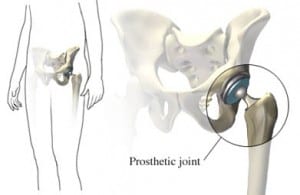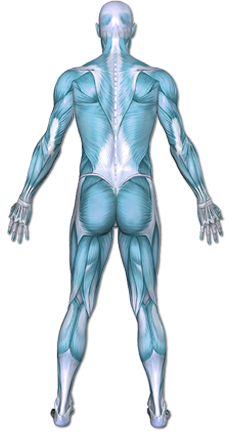Total Hip Replacement
A total hip replacement is a surgery to replace a diseased or injured hip joint. An artificial ball-and-socket joint is inserted to make a new hip. It can be done by full open surgery or a minimally invasive technique.
The minimally invasive technique only requires one or two small incisions and special instruments. People eligible for this surgery are typically:
• Younger than 50
• Of normal weight
• Healthier than those who have the traditional total hip replacement surgery


This content was created using EBSCO’s Health Library
This surgery is done when pain and stiffness limit your normal activities and rest, medicine, and physical therapy are no longer working. Other reasons for surgery may include a broken hip, severe rheumatoid arthritis, bone tumors, and loss of blood supply to the bones of the hip.
This content was created using EBSCO’s Health Library
If you are planning to have a hip replacement, your doctor will review a list of possible complications, which may include:
- Hip dislocation, which is the most common complication—occurs when the ball portion of the prosthesis dislocates from its normal position in the hip
- Infection
- Blood clots
- Swelling or bleeding
- Injury to nearby nerves or blood vessels
- Anesthesia-related problems, like pneumonia
- Noisy or squeaky hip after surgery
Factors that may increase the risk of complications include:
- Pre-existing medical condition, such as heart or lung problems
- Obesity
- Infection, such as urinary tract infection or gum disease—having an infection increases the risk of bacteria entering the bloodstream and infecting the joint.
- Previous problems with blood clots
- Smoking
Be sure to discuss these risks with your doctor before the surgery.
This content was created using EBSCO’s Health Library
Total Hip Replacement
An incision is made along your joint. The muscles are moved aside. The damaged bone and cartilage of the hip joint are removed. The remaining bone will be prepared for the prosthesis. The new artificial joint will be placed in position. Depending on the type of prosthesis, the doctor may use bone cement to hold one or both parts of the artificial hip firmly to your bone. Lastly, the incision will be closed with stitches or staples.
Minimally Invasive Total Hip Replacement
This surgery may be done with one or two small incisions, one over the groin and another over the buttock. Special tools are used that fit into these small incisions. In some cases, x-rays will be used to help guide the doctor. For the one-incision surgery, an incision will be made over the outside of your hip. The muscles and tendons will be moved out of the way. Next, the damaged bone and cartilage of the hip joint will be removed. The remaining bone will be prepared for the prosthesis. The new artificial joint will then be placed in position. Depending on the type of prosthesis, bone cement may be used to hold the artificial hip in place. Lastly, the incision will be closed with stitches or staples.
This content was created using EBSCO’s Health Library
At the Hospital
While you are recovering at the hospital, you may need to:
- Walk with help, using a walker, on the day after surgery.
- Be careful. A fall can damage or dislocate the new joint. Do not try to walk without help.
- Take medicine to prevent blood clots.
- Wear compression boots or stockings.
- Begin physical therapy to regain mobility and strength.
- Breathe deeply and cough 10-20 times every hour—This will decrease the risk of fluid build-up in the lungs. The fluid can cause pneumonia.
At Home
When you return home, do the following to help ensure a smooth recovery:
- Keep the incision area clean and dry.
- Ask your doctor about when it is safe to shower, bathe and soak in water.
- When seated, place a V-shaped pillow between your legs. This will help you to maintain correct positioning of your hip.
- Work with the physical therapist. You will learn how to move your hip and maintain proper alignment. You should also talk to your doctor and physical therapist about ways to prevent dislocations. Depending on your surgery, you may need to avoid crossing your legs, flexing your hips more than 90 degrees, and turning your feet very far inward or outward.
- Only take medicines recommended by your doctor. Do not take over-the-counter remedies without your doctor’s approval.
- Maintain a healthy weight. Obesity can increase wear on your new joint.
- Avoid jogging and other high-impact sports. This can also increase wear on the joint, cause it to loosen, and cause pain.
- Be sure to follow your doctor’s instructions.
Antibiotics may be needed before certain dental procedures or surgeries now that you have an artificial joint. This will prevent possible infections from entering the bloodstream. Make sure to let the dentist or doctor know that you have an artificial joint. Within six weeks, you should be able to resume normal, light activities. A replaced hip typically lasts 10-15 years.
Call Your Doctor
After you leave the hospital, contact your doctor if any of the following occur:
- Signs of infection, including fever and chills
- Redness, swelling, increasing pain, excessive bleeding, or discharge around incision site
- Pain and/or swelling in the feet, calves, or legs
- Cough, shortness of breath, chest pain
- Severe nausea or vomiting
- Hip pain that you cannot control with the medicines you have been given or that becomes worse
- Numbness, tingling, or loss of feeling in your leg, knee, or foot
In case of an emergency, call for medical help right away.
This content was created using EBSCO’s Health Library
Work with the physical therapist. You will learn how to move your hip and maintain proper alignment. You will be put on an exercise program to increase your strength and balance. Your physical therapist will work with you until you no longer need a cane or walker to walk. You should also talk to your doctor and physical therapist about ways to prevent dislocations. Depending on your surgery, you may need to avoid crossing your legs, flexing your hips more than 90 degrees, and turning your feet very far inward or outward.
This content was created using EBSCO’s Health Library
This content was created using EBSCO’s Health Library
This content was created using EBSCO’s Health Library


